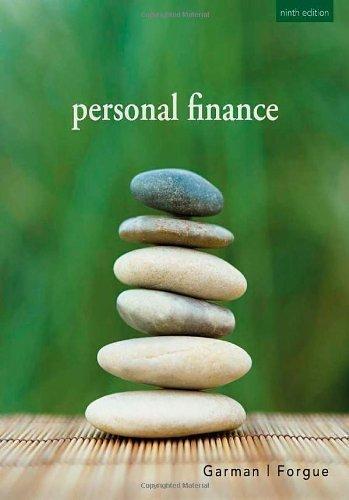Question
Just options are enough.Thank you. 1. The objectives or goals of financial management are to maximize a. sales b. profits c. owner.s wealth d. total
Just options are enough.Thank you.
1. The objectives or goals of financial management are to maximize
a. sales
b. profits
c. owner.s wealth
d. total assets
2. The two basic types of stock are
a. Class A and Class B
b. Class A Common and Class B Common
c. Convertible and Common
d. Common and Preferred
3. If you borrow $500 for one year and agree to repay the lender $540 at the end of one year, the interest cost of borrowing is
a. 8% per year
b. $40
c. neither (a) nor (b)
d. both (a) and (b)
4. Using the net present value method, the decision to accept an "accept-reject" investment proposal would occur when the net present value is
a. greater than or equal to zero
b. less than or equal to zero
c. equal to zero
d. less than zero
5. A short-term unsecured promissory note issued by a corporation with a high credit standing is called a
a. money market mutual fund
b. commercial paper
c. repurchase agreement
d. negotiable certificate of deposit
6. A bond pays $60 per year in interest and has a $1000 par value. The market rate of interest is 8%. What is the coupon rate for this bond?
a. 2%
b. 6%
c. 8%
d. 14%
7. A firm in the 40% marginal tax bracket pays a bank 10% on a loan. What is the after-tax cost of debt for the firm?
a. 4%
b. 6%
c. 10%
d. 14%
8. The major financial assets of a firm do NOT include
a. turnover ratios
b. liquidity ratios
c. accrued ratios
d. profitability ratios
9. As the interest rate goes up, the present value of a future amount will
a. go up
b. go down
c. remain the same
d. fluctuate
10. If a firm undertakes all worthwhile projects and pays out dividends when and only when funds are available, it follows the
a. asymmetric dividend theory
b. dividend signaling hypothesis
c. impairment of capital theory
d. residual theory of dividends
11. What cash discount is provided by "terms 2/10 net 45 End of Month (EOM)"?
a. 2% discount if paid in 10 days; if no cash discount is taken, balance is due 45 days after the end of the month
b. 2% discount if paid in 10 days; if no cash discount is taken, balance is due 45 days after completion of the transaction
c. 10% discount if paid in 2 days; if no cash discount is taken, balance is due 45 days after completion of the transaction
d. 10% discount if paid in 2 days; if no cash discount is taken, balance is due 45 days after the end of the month
12. A share of common stock that paid a $3 dividend last year is expected to have a 6% annual growth rate. The required rate of return is 14%. Next year.s dividend is expected to be
a. $3.00
b. $3.06
c. $3.18
d. $3.42
13. A project that costs $1000 to undertake and generates $200 per year in revenues for 8 years, has a present value of $1067. Which of the following is true?
a. The net present value of the project is $2067.
b. The net present value of the project is $1067.
c. The net present value of the project is $67.
d. The project should not be undertaken.
14. A reasonable short-term financial decision for a multinational company that expects a local foreign currency to appreciate is to
a. increase local accounts receivable and decrease local accounts payable
b. increase both local inventories and local notes payable
c. increase both local customers accounts receivable and local notes payable
d. decrease both local notes receivable and accruals
15. If the cash discount period is increased, the firm.s investment in accounts receivable due to discount takers still getting cash discounts but paying later is expected to
a. increase
b. remain unchanged
c. decrease
d. change, but the direction of change cannot be determined
16. A bond that has a yield to maturity of 14% and a current yield of 8%
a. sells at a premium
b. sells at par
c. has a coupon rate in excess of the market rate of interest
d. has a coupon rate less than the market rate of interest
17. A firm has common stock outstanding that paid a $2 dividend last year. This stock has a 6% expected growth rate. If you have a 10% required rate of return, what is the most you should pay for this stock?
a. $12.50
b. $35.33
c. $50.00
d. $53.00
18. A firm has a current ratio of 2.4, a quick ratio of 1.5, an inventory turnover of 6 times, and current liabilities of $600,000. What is the firm.s level of sales?
a. $1,420,000
b. $1,960,000
c. $2,160,000
d. $3,240,000
19. The present value of an annuity for 5 years at 10% is 3.7908. The future value of an annuity for 5 years at 10% is 6.1051. How much will you have to pay each year on a $10,000 mortgage at 10% interest with a 5 year maturity?
a. $1,594.36
b. $2,637.97
c. $3,790.80
d. $6,105.10
20. A firm that must pay $2,000,000 in preferred dividends has $3,000,000 available for preferred and common dividends. It has 400,000 shares of common stock outstanding, and a .4 dividend payout ratio. The firm.s dividend per common share is
a. $1.00
b. $1.50
c. $5.00
d. $7.50
Step by Step Solution
There are 3 Steps involved in it
Step: 1

Get Instant Access to Expert-Tailored Solutions
See step-by-step solutions with expert insights and AI powered tools for academic success
Step: 2

Step: 3

Ace Your Homework with AI
Get the answers you need in no time with our AI-driven, step-by-step assistance
Get Started


